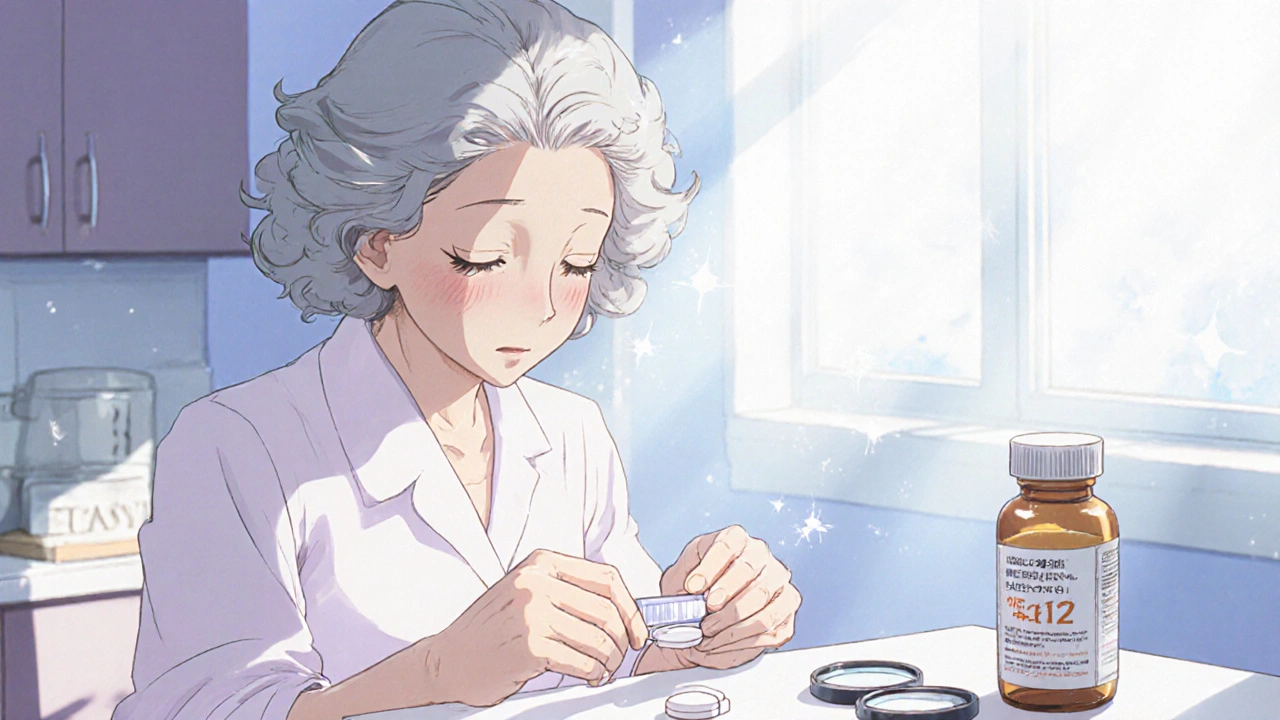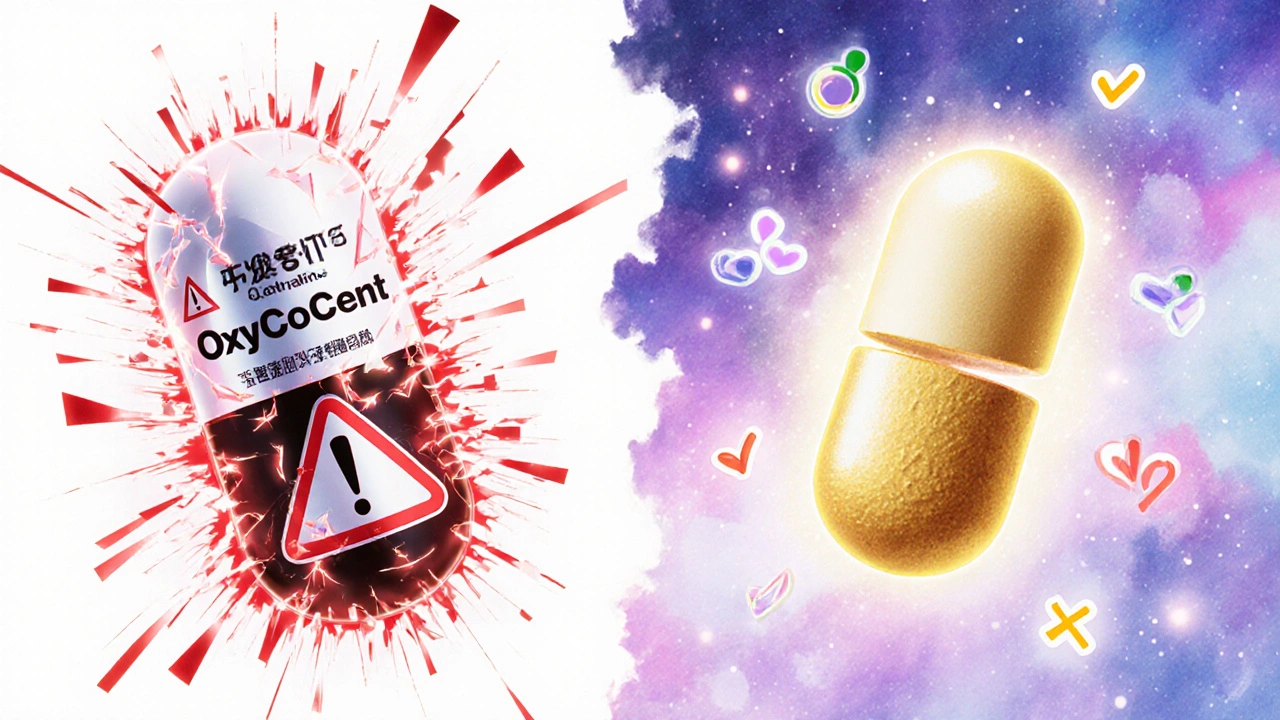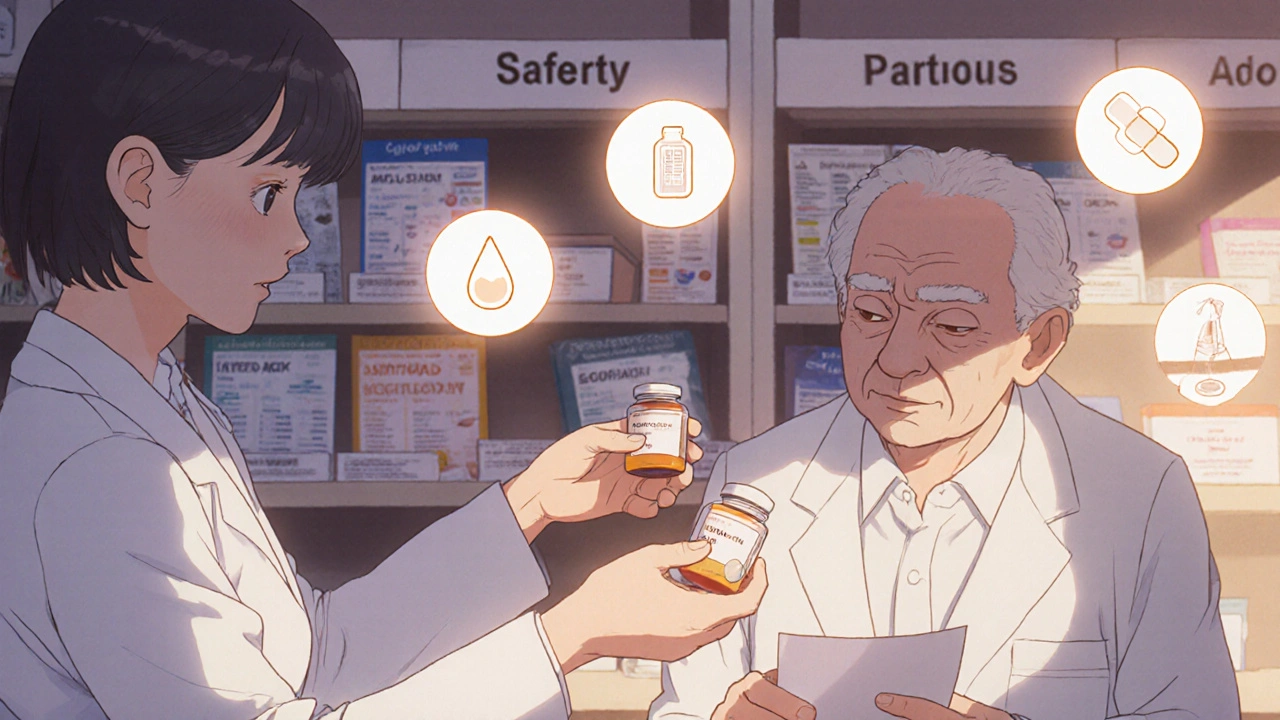
Splitting pills might seem like a simple way to save money or make swallowing easier, but it’s not always safe. Many people do it without knowing the risks - and that’s where things can go wrong. A 2023 survey found that 41% of adults over 65 split their pills without talking to a doctor or pharmacist first. That’s a dangerous habit. Some pills are designed to be split. Others can become dangerous, ineffective, or even toxic when cut. The key isn’t just whether the pill has a score line - it’s what’s inside it.
Why People Split Pills
People split pills for three main reasons: cost, size, and availability. A 10mg tablet often costs the same as a 5mg one. Splitting the 10mg gives you two doses for the price of one. For medications like amlodipine or sertraline, that can save $20 to $30 a month. That adds up fast, especially on a fixed income. Others split pills because swallowing large tablets is hard. About 14% of adults over 65 have trouble swallowing pills, according to the National Institute on Aging. Splitting makes it easier. And sometimes, a lower dose just isn’t made by the manufacturer. Splitting becomes the only option. But here’s the catch: not all pills are built the same. What looks like a simple tablet might be hiding a complex delivery system. Splitting the wrong one can change how the drug works - or make it unsafe.Medications That Are Safe to Split
The safest pills to split are immediate-release tablets with a clear score line. These are designed to break evenly. The score isn’t just for show - it’s part of the manufacturing process. According to the FDA and the Institute for Safe Medication Practices, these medications are generally safe to split when done properly:- Citalopram (Celexa)
- Escitalopram (Lexapro)
- Fluvoxamine (Luvox)
- Sertraline (Zoloft)
- Amlodipine (Norvasc)
- Hydrochlorothiazide (HCTZ)
- Atorvastatin (Lipitor)
- Metoprolol (Lopressor, Toprol XL - only immediate-release version)
Medications That Should Never Be Split
Some pills are never safe to split - no matter how badly you need to save money or make them easier to swallow. Extended-release, controlled-release, or sustained-release tablets are the biggest danger. These pills have special coatings or matrices that control how the drug is released over hours. Splitting them destroys that system. The entire dose can rush into your system at once. That’s how people end up in the ER with dangerously high blood pressure, heart rate, or sedation. Examples of unsafe extended-release pills:- Oxycodone extended-release (OxyContin)
- Verapamil SR
- Metoprolol succinate (Toprol XL)
- Propranolol ER
- Duloxetine delayed-release (Cymbalta)

How to Split Pills Safely
If your doctor or pharmacist says it’s okay to split your pill, here’s how to do it right:- Use a dedicated tablet cutter. Don’t use scissors, knives, or your fingers. A $10 plastic cutter from the pharmacy is all you need.
- Split one pill at a time. Never split your whole month’s supply. Exposure to air and moisture can reduce potency by up to 35% in just 72 hours, according to ISMP.
- Store split halves in an opaque, airtight container. Light and humidity degrade pills faster.
- Use the split pill within 24 hours. If you can’t use it that day, throw it out. Don’t risk inconsistent dosing.
- Wash your hands before and after handling pills.
- Check the pill after splitting. If it crumbles, looks uneven, or has dust on it - don’t take it.
When Splitting Isn’t Worth the Risk
Cost savings sound great, but they’re only worth it if they don’t cost you your health. For example, a 10mg amlodipine tablet might save you $28.50 a month over two 5mg tablets. But if you split it poorly and end up with a 7mg dose one day and 3mg the next, your blood pressure could swing dangerously. That’s not saving money - that’s risking a stroke. Many manufacturers now offer lower-dose versions of popular drugs. Yes, they cost more - but they’re 99.8% accurate. A 2022 Express Scripts analysis found that while splitting saves money, the hidden costs of errors - ER visits, hospital stays, extra doctor visits - can wipe out the savings. And let’s not forget the human factor. A 2022 Arthritis Foundation survey found that 42% of seniors with arthritis gave up on splitting pills because they couldn’t handle the cutter. If it’s too hard, it’s not worth it. Ask your pharmacist about liquid forms, orally disintegrating tablets, or lower-dose options.
What to Do Before You Split
Never assume a pill can be split just because it has a score line. A 2023 FDA review found that 32% of scored tablets still don’t split evenly due to how they’re made. That’s why the best rule is simple: Always ask your pharmacist. Pharmacists are trained to know which pills are safe to split and which aren’t. In a 2021 survey by the National Community Pharmacists Association, 78% of pharmacists said they routinely warn patients against splitting unless the package insert says it’s okay. Check the medication guide or package insert. Look for phrases like:- “May be split if prescribed”
- “Do not crush or split”
- “For oral use only - do not divide”
Alternatives to Pill Splitting
If splitting feels risky or too hard, there are better options:- Ask your doctor for a lower-dose tablet - even if it costs a bit more.
- Switch to a liquid form. Many blood pressure and antidepressant meds come in liquids.
- Try orally disintegrating tablets (ODTs). These dissolve on the tongue - no swallowing needed.
- Use a pill organizer with pre-sorted doses. Some pharmacies offer this service for free.
- Ask about patient assistance programs. Many drug makers offer discounts or free meds to those who qualify.
Final Thoughts
Pill splitting isn’t inherently bad. But it’s not harmless, either. It’s a tool - and like any tool, it needs to be used correctly. For some, it’s a lifeline. For others, it’s a hidden risk. The bottom line: if you’re thinking about splitting a pill, talk to your pharmacist first. Don’t rely on Google, Reddit, or what your friend does. Your medication is personal. Your safety is too. If your pill is scored, immediate-release, and your pharmacist says it’s okay - go ahead. Use a cutter. Split one at a time. Use it right away. If it’s not? Don’t risk it. There’s always a safer way.Can I split my pill with scissors or a knife?
No. Scissors, knives, or your fingers lead to uneven splits, dust, and inaccurate doses. A dedicated tablet cutter is designed to give consistent halves. Using anything else increases the risk of taking too much or too little - which can cause side effects or make your treatment fail.
Is it safe to split pills that have a score line?
Not always. While a score line suggests splitting is possible, 32% of scored tablets still don’t split evenly due to how they’re manufactured. Always check the package insert or ask your pharmacist. Some scored pills are extended-release or enteric-coated - and splitting them can be dangerous.
Can I split my pills ahead of time for the whole week?
No. Splitting pills in advance exposes them to air and moisture, which can reduce potency by up to 35% within 72 hours. Always split one pill at a time, right before you take it. Store split halves in an airtight container and use them within 24 hours.
What if I accidentally split a pill that shouldn’t be split?
If you split an extended-release, enteric-coated, or hazardous pill, don’t take it. Throw it away. Contact your pharmacist or doctor immediately. Taking a split extended-release pill can cause a dangerous overdose. Even if you feel fine, the drug may release too quickly and cause harm hours later.
Are there apps that help with pill splitting?
Yes. As of 2023, 42% of major pharmacy chains offer apps with visual guides, dose calculators, and safety alerts for pill splitting. These tools reduce errors by 29% according to Walgreens’ internal data. They can tell you if your pill is safe to split and how to do it correctly.
Josh Gonzales
November 26, 2025 AT 09:48Just got back from the pharmacy and asked about my amlodipine. They said it’s fine to split with a cutter but to never do it ahead of time. Also warned me that the generic version sometimes crumbles even with a score line. Always check the batch. I’ve seen people use kitchen shears and it’s a mess. A $12 plastic cutter from Walmart lasts years.
Valérie Siébert
November 28, 2025 AT 08:28OMG YES I’VE BEEN DOING THIS WRONG FOR YEARS 😭 I split my zoloft with a knife because my cutter broke and I thought ‘eh it’s fine’… now I’m scared to even swallow the damn thing. Gonna buy a new cutter today and split one pill at a time like the article says. Thanks for the wake up call.
Jacqueline Aslet
November 28, 2025 AT 08:45It is an epistemological paradox that individuals, driven by economic precarity, resort to the mechanical deconstruction of pharmaceuticals-thereby introducing ontological uncertainty into their own physiological integrity. The act of splitting, while ostensibly pragmatic, undermines the very epistemic authority of pharmacological science. One must ask: Is cost-efficiency a moral imperative, or merely a symptom of systemic neglect?
Caroline Marchetta
November 29, 2025 AT 09:24Oh sweet mercy, another ‘educational’ post that makes me feel like a criminal for trying to survive on $1,200 a month. Of course I know I shouldn’t split my pills. But tell that to the pharmacist who told me ‘it’s fine’ last Tuesday. Or the 78-year-old widow who’s been doing it for 12 years and still walks her dog every morning. The real danger isn’t the pill-it’s the system that forces people to gamble with their lives just to afford the next dose.
Jack Riley
November 30, 2025 AT 02:26Let’s be real-this whole article reads like a pharmaceutical industry pamphlet. You say ‘ask your pharmacist’ like they’re saints. I’ve had pharmacists tell me to split things they later admitted they weren’t sure about. And let’s not pretend generics are identical to brand names. The FDA allows 20% variation in bioavailability. Splitting a pill with 20% variation? That’s not medicine-that’s Russian roulette with a score line. If you want safety, stop trusting corporations and start demanding affordable low-dose options. Until then, people will split pills. Because survival isn’t a privilege-it’s a rebellion.
Rachel Villegas
November 30, 2025 AT 14:37I split my metoprolol every day with a cutter and store the halves in a small amber jar. I use them within 12 hours. Never had an issue. My doctor and pharmacist both approved it. The key is consistency and tool quality. Don’t overthink it-just do it right. And if you’re shaky? Ask for liquid. There’s no shame in it.
katia dagenais
December 1, 2025 AT 11:06Okay but let’s talk about the real elephant in the room: why does the US even have this problem? In Canada, Germany, France-meds are priced so that splitting is a novelty, not a necessity. We’re not just bad at pill splitting-we’re victims of a broken healthcare economy. The fact that a 10mg tablet costs the same as a 5mg one isn’t an accident-it’s a business model designed to extract maximum profit from people who can’t afford to be healthy. And now we’re supposed to be grateful for a $10 cutter? That’s not safety advice. That’s gaslighting with a plastic hinge.
Josh Zubkoff
December 1, 2025 AT 18:49Let me just say this: I’ve been splitting my Cymbalta for three years because my insurance won’t cover the 30mg version. I’ve used a cutter, I’ve stored them properly, I’ve split one at a time. I’ve never had side effects. Meanwhile, my cousin took the whole 60mg tablet thinking it was 30mg and ended up in the ER. So yeah-splitting can be dangerous. But so can being too scared to take your meds at all. The real villain isn’t the pill. It’s the insurance company that won’t cover the dose you need. And the doctors who don’t even ask if you can afford it. This whole article reads like a PSA written by someone who’s never had to choose between rent and refills.